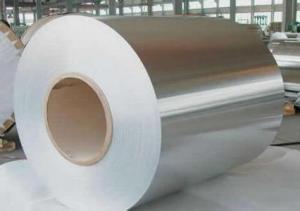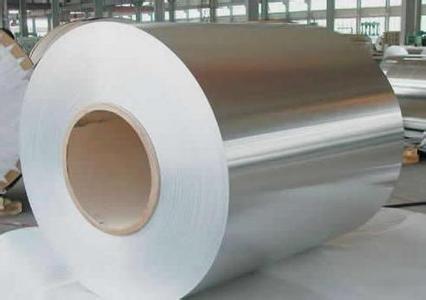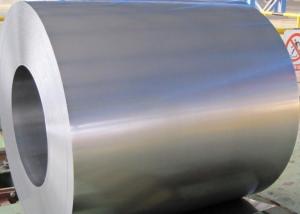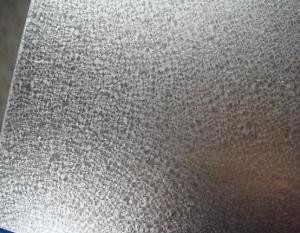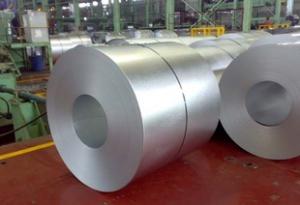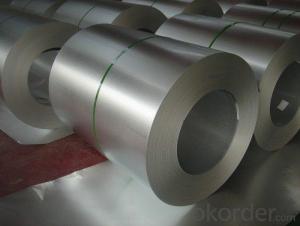Hot dipped Aluzinc Steel Coil AZ150
- Loading Port:
- China Main Port
- Payment Terms:
- TT or LC
- Min Order Qty:
- -
- Supply Capability:
- -
OKorder Service Pledge
Quality Product, Order Online Tracking, Timely Delivery
OKorder Financial Service
Credit Rating, Credit Services, Credit Purchasing
You Might Also Like
PREPAINTED ALUZINC STEEL COIL
Specification:122O*O.47
Steel Grade & Standard: CG20140923
AZ150
Surface Treatment: non-chromate, oiled
Coil ID:508mm Coil Weight:6-10MT
Package Type:EYE TO SIDE
Thickness Tolerance:+/-0.02mm Width Tolerance:+/-5mm
Zinc Coating Tolerance:-/+10g/m2
- Q: What are the different types of steel coil packaging materials used during processing?
- Some of the different types of steel coil packaging materials used during processing include steel strapping, plastic strapping, stretch film, shrink wrap, and coil covers.
- Q: What are the safety precautions for handling steel coils?
- When handling steel coils, some important safety precautions to follow include wearing appropriate personal protective equipment (PPE) such as gloves, safety glasses, and steel-toed boots. It is essential to use proper lifting techniques and equipment to prevent strains or injuries. Securing the coils properly during transportation or storage is crucial to avoid accidents or damage. Regular inspections of the coils and their surroundings should be conducted to identify any potential hazards or defects. Additionally, training employees on safe handling procedures and establishing clear communication protocols can contribute to a safer working environment.
- Q: Why is steel so important? How does it help us in everyday life?
- steel comes from iron. Iron is a natural resource and is abundent in nature. so being able to turn it into steel means it can be used for alllll sorts of things! from buildings, cars, piping and tubes, to washing machines, appliances and many other things. its used in our everyday life and is a great, strong material.
- Q: How are steel coils processed for different finishes?
- Steel coils can be processed for different finishes through various methods. One common process is called coil coating, where the steel coil is cleaned, primed, coated, and cured to achieve a desired finish. This process includes removing any contaminants from the surface of the coil, applying a primer to enhance adhesion, and then coating it with a specific paint or coating material. The coated coil is then cured at high temperatures to ensure proper adhesion and durability. Another method for processing steel coils is through galvanization. In this process, the steel coil is coated with a layer of zinc to protect it from corrosion. This can be done through hot-dip galvanization, where the coil is immersed in a bath of molten zinc, or through electro-galvanization, where a thin layer of zinc is electroplated onto the coil. The galvanized finish provides excellent corrosion resistance and can be further processed to achieve different aesthetic finishes. Additionally, steel coils can be processed for different finishes through various surface treatments. This may involve processes such as pickling, where the coil is treated with an acid solution to remove scale and impurities, or mechanical treatments like brushing or grinding to achieve a desired texture. These surface treatments can be followed by applying a protective coating or paint to enhance the appearance and durability of the coil. Overall, the process of achieving different finishes on steel coils involves a combination of cleaning, coating, curing, and surface treatments. The choice of specific methods depends on the desired finish and the intended application of the steel coil.
- Q: Are steel or graphite clubs better?
- If its for your bf, i would buy steel. Most guys prefer steel because it is more accurate and it think every guy on the pga tour uses steel shafted irons. Steel also usually costs less, which helps. Neither one is better, its just a matter of personal preference.
- Q: What are the different types of steel coil slitting processes?
- There are several different types of steel coil slitting processes, each with its own benefits and considerations. Here are some of the most common types: 1. Rotary slitting: This is the most traditional and widely used slitting process. It involves a rotating circular blade that cuts through the coil. Rotary slitting is highly precise and can produce narrow strips, making it suitable for a wide range of applications. 2. Loop slitting: In this process, the coil is fed through a loop before being cut. Loop slitting allows for high-speed processing and can handle thicker materials. It is commonly used for heavy-duty applications and large coils. 3. Drag slitting: Also known as shear slitting, this process uses a stationary blade that pulls the material through to make the cut. Drag slitting is suitable for thinner materials and offers a high-quality edge finish. 4. Crush slitting: This process involves pressing the material between two rollers to make the cut. Crush slitting is commonly used for delicate materials that require a gentle cutting action. It can produce clean cuts and minimize burrs. 5. Laser slitting: As the name suggests, this process uses a laser beam to cut through the coil. Laser slitting offers high precision and can handle a wide range of materials. It is particularly useful for specialty steels and thin strips. Each type of steel coil slitting process has its own advantages and limitations, so it's important to consider factors such as material thickness, coil size, and required strip width when choosing the appropriate method. Additionally, factors like cost, speed, and edge finish should also be taken into account to determine the best process for a specific application.
- Q: How are steel coils used in the production of metal signs?
- Steel coils are used in the production of metal signs as they provide a durable and versatile material for creating the sign's base. The coils are unwound and flattened to form sheets, which are then cut into desired shapes and sizes. These steel sheets can be easily manipulated and bent to create the desired design for the sign. Additionally, the strength and resilience of steel make it an ideal material for outdoor signs, as it can withstand harsh weather conditions and maintain its structural integrity over time.
- Q: What are the common methods of protecting steel coils from corrosion during storage?
- There are several common methods used to protect steel coils from corrosion during storage. These methods are employed to prevent moisture and other environmental elements from coming into contact with the steel coils, which can lead to corrosion. 1. VCI (Volatile Corrosion Inhibitor) Packaging: VCI packaging is a widely used method for protecting steel coils. VCI materials are incorporated into the packaging, such as plastic bags or films, which release a vapor that forms a protective layer on the surface of the steel coils. This layer prevents moisture and other corrosive agents from reaching the steel, thus inhibiting corrosion. 2. Oil Coating: Another widely used method is to apply a thin layer of oil on the surface of the steel coils. The oil acts as a barrier, preventing moisture and oxygen from coming into contact with the steel. This method is particularly effective for long-term storage or transportation of steel coils. 3. Desiccants: Desiccants, such as silica gel packets, can be placed inside the packaging to absorb any moisture that may be present. By reducing the humidity levels inside the packaging, the risk of corrosion is minimized. This method is often used in conjunction with VCI packaging or oil coating. 4. Proper Ventilation: Adequate ventilation is necessary to prevent the accumulation of moisture around the steel coils during storage. By allowing air to circulate freely, it helps to reduce the humidity levels and prevents the formation of condensation, which can lead to corrosion. 5. Controlled Environment: Storing steel coils in a controlled environment can be an effective way to prevent corrosion. This involves maintaining a constant temperature and humidity level, which are not conducive to corrosion. Temperature and humidity control can be achieved through the use of air conditioning or dehumidification systems. It is important to note that the specific method or combination of methods used to protect steel coils will depend on various factors, such as the duration of storage, the environmental conditions, and the specific requirements of the steel coils. Regular inspections and maintenance are also crucial to ensure the ongoing protection of the steel coils from corrosion.
- Q: How are steel coils used in the manufacturing of electrical equipment?
- Steel coils are used in the manufacturing of electrical equipment as they serve as the core material for transformers and inductors. These coils are wound with copper wire to create electromagnetic fields necessary for the functioning of various electrical devices.
- Q: I would like to build steel galvanization plant.
- Galvanising Plant
Send your message to us
Hot dipped Aluzinc Steel Coil AZ150
- Loading Port:
- China Main Port
- Payment Terms:
- TT or LC
- Min Order Qty:
- -
- Supply Capability:
- -
OKorder Service Pledge
Quality Product, Order Online Tracking, Timely Delivery
OKorder Financial Service
Credit Rating, Credit Services, Credit Purchasing
Similar products
Hot products
Hot Searches
Related keywords
